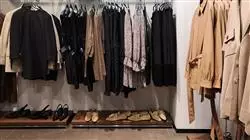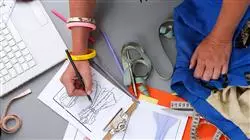University certificate
The world's largest faculty of design”
Introduction to the Program
The creation of garments is a complex task that requires a high level of specialization, but also ingenuity and creativity. With this Postgraduate diploma, you will learn the keys to successfully manage in this field"

In a sector in constant growth and evolution as the fashion industry, specializing in Styling and Clothing is essential to know those little details that make the difference and will make a collection succeed in the market. Undoubtedly, nowadays, higher specialization is a demand in almost any sector, and, in fashion, it cannot be left aside. For this reason, TECH Global University has created this Postgraduate diploma in Styling and Clothing, with a highly up-to-date program focused on the history of Clothing, Fashion and Styling.
In this way, students will have access to a multitude of theoretical and practical resources, thanks to which they will be able to learn first-hand how the evolution of clothing has been until reaching the current concept and uses. In this way, they will review from prehistoric costumes to the most current dresses of the most renowned designers.
With all this, TECH Global University aims to meet the high specialization objective demanded by fashion designers, who are looking for high quality programs to increase their education and offer users garments that become indispensable for their closet. And, to achieve this goal, it offers a cutting-edge program adapted to the latest developments in the sector, with an absolutely current syllabus and carried out by experienced professionals, willing to put all their knowledge at the disposal of their students. It should be noted that, being a 100% online Postgraduate diploma, students will not be conditioned by fixed schedules or the need to move to another physical location, but will be able to access all the contents at any time of the day, balancing their work and personal life with their academic one.
Access to a multitude of practical cases and specialize to work in a cutting-edge sector"
This Postgraduate diploma in Styling and Clothing contains the most complete and up-to-date program on the market. The most important features include:
- The development of practical cases presented by experts in fashion
- The graphic, schematic, and practical contents with which they are created, provide practical information on the disciplines that are essential for professional practice
- Practical exercises where self-assessment can be used to improve learning
- Special emphasis on innovative methodologies in Styling and Clothing
- Theoretical lessons, questions to the expert, debate forums on controversial topics, and individual reflection assignments
- Content that is accessible from any fixed or portable device with an Internet connection
TECH provides you with the most relevant information on Styling and Clothing so that you can enter a sector of great importance in Fashion Design"
Its teaching staff includes professionals from the fashion industry, who bring to this program the experience of their work, as well as renowned specialists from leading societies and prestigious universities.
Its multimedia content, developed with the latest educational technology, will allow professionals to learn in a contextual and situated learning environment, i.e., a simulated environment that will provide immersive specialization for real situations.
The design of this program focuses on Problem-Based Learning, by means of which professionals must try to solve the different professional practice situations that are presented to them throughout the academic year. For this purpose, professionals will be assisted by an innovative interactive video system created by renowned and experienced experts.
The fashion industry is a very competitive sector, so the higher specialization of professionals will be a plus for their employability"

This online program will allow you to organize your study time and self-manage your learning"
Why study at TECH?
TECH is the world’s largest online university. With an impressive catalog of more than 14,000 university programs available in 11 languages, it is positioned as a leader in employability, with a 99% job placement rate. In addition, it relies on an enormous faculty of more than 6,000 professors of the highest international renown.

Study at the world's largest online university and guarantee your professional success. The future starts at TECH”
The world’s best online university according to FORBES
The prestigious Forbes magazine, specialized in business and finance, has highlighted TECH as “the world's best online university” This is what they have recently stated in an article in their digital edition in which they echo the success story of this institution, “thanks to the academic offer it provides, the selection of its teaching staff, and an innovative learning method aimed at educating the professionals of the future”
A revolutionary study method, a cutting-edge faculty and a practical focus: the key to TECH's success.
The most complete study plans on the university scene
TECH offers the most complete study plans on the university scene, with syllabuses that cover fundamental concepts and, at the same time, the main scientific advances in their specific scientific areas. In addition, these programs are continuously being updated to guarantee students the academic vanguard and the most in-demand professional skills. In this way, the university's qualifications provide its graduates with a significant advantage to propel their careers to success.
TECH offers the most comprehensive and intensive study plans on the current university scene.
A world-class teaching staff
TECH's teaching staff is made up of more than 6,000 professors with the highest international recognition. Professors, researchers and top executives of multinational companies, including Isaiah Covington, performance coach of the Boston Celtics; Magda Romanska, principal investigator at Harvard MetaLAB; Ignacio Wistumba, chairman of the department of translational molecular pathology at MD Anderson Cancer Center; and D.W. Pine, creative director of TIME magazine, among others.
Internationally renowned experts, specialized in different branches of Health, Technology, Communication and Business, form part of the TECH faculty.
A unique learning method
TECH is the first university to use Relearning in all its programs. It is the best online learning methodology, accredited with international teaching quality certifications, provided by prestigious educational agencies. In addition, this disruptive educational model is complemented with the “Case Method”, thereby setting up a unique online teaching strategy. Innovative teaching resources are also implemented, including detailed videos, infographics and interactive summaries.
TECH combines Relearning and the Case Method in all its university programs to guarantee excellent theoretical and practical learning, studying whenever and wherever you want.
The world's largest online university
TECH is the world’s largest online university. We are the largest educational institution, with the best and widest online educational catalog, one hundred percent online and covering the vast majority of areas of knowledge. We offer a large selection of our own degrees and accredited online undergraduate and postgraduate degrees. In total, more than 14,000 university degrees, in eleven different languages, make us the largest educational largest in the world.
TECH has the world's most extensive catalog of academic and official programs, available in more than 11 languages.
Google Premier Partner
The American technology giant has awarded TECH the Google Google Premier Partner badge. This award, which is only available to 3% of the world's companies, highlights the efficient, flexible and tailored experience that this university provides to students. The recognition as a Google Premier Partner not only accredits the maximum rigor, performance and investment in TECH's digital infrastructures, but also places this university as one of the world's leading technology companies.
Google has positioned TECH in the top 3% of the world's most important technology companies by awarding it its Google Premier Partner badge.
The official online university of the NBA
TECH is the official online university of the NBA. Thanks to our agreement with the biggest league in basketball, we offer our students exclusive university programs, as well as a wide variety of educational resources focused on the business of the league and other areas of the sports industry. Each program is made up of a uniquely designed syllabus and features exceptional guest hosts: professionals with a distinguished sports background who will offer their expertise on the most relevant topics.
TECH has been selected by the NBA, the world's top basketball league, as its official online university.
The top-rated university by its students
Students have positioned TECH as the world's top-rated university on the main review websites, with a highest rating of 4.9 out of 5, obtained from more than 1,000 reviews. These results consolidate TECH as the benchmark university institution at an international level, reflecting the excellence and positive impact of its educational model.” reflecting the excellence and positive impact of its educational model.”
TECH is the world’s top-rated university by its students.
Leaders in employability
TECH has managed to become the leading university in employability. 99% of its students obtain jobs in the academic field they have studied, within one year of completing any of the university's programs. A similar number achieve immediate career enhancement. All this thanks to a study methodology that bases its effectiveness on the acquisition of practical skills, which are absolutely necessary for professional development.
99% of TECH graduates find a job within a year of completing their studies.
Postgraduate Diploma in Styling and Clothing
.
If you are passionate about the world of fashion and want to become an expert in styling and clothing, you've come to the right place. At TECH you will find a complete Postgraduate Diploma in Styling and Clothing, through which you will learn to analyze the personal style of each client, managing to create unique and attractive looks adapted to their personality and occasion. In addition, you will learn about current trends, make-up and hairstyle techniques, and the selection of colors and garments suitable for each body type. As a result, you will be empowered to develop your own image consulting business, establishing a solid presence in the market.







